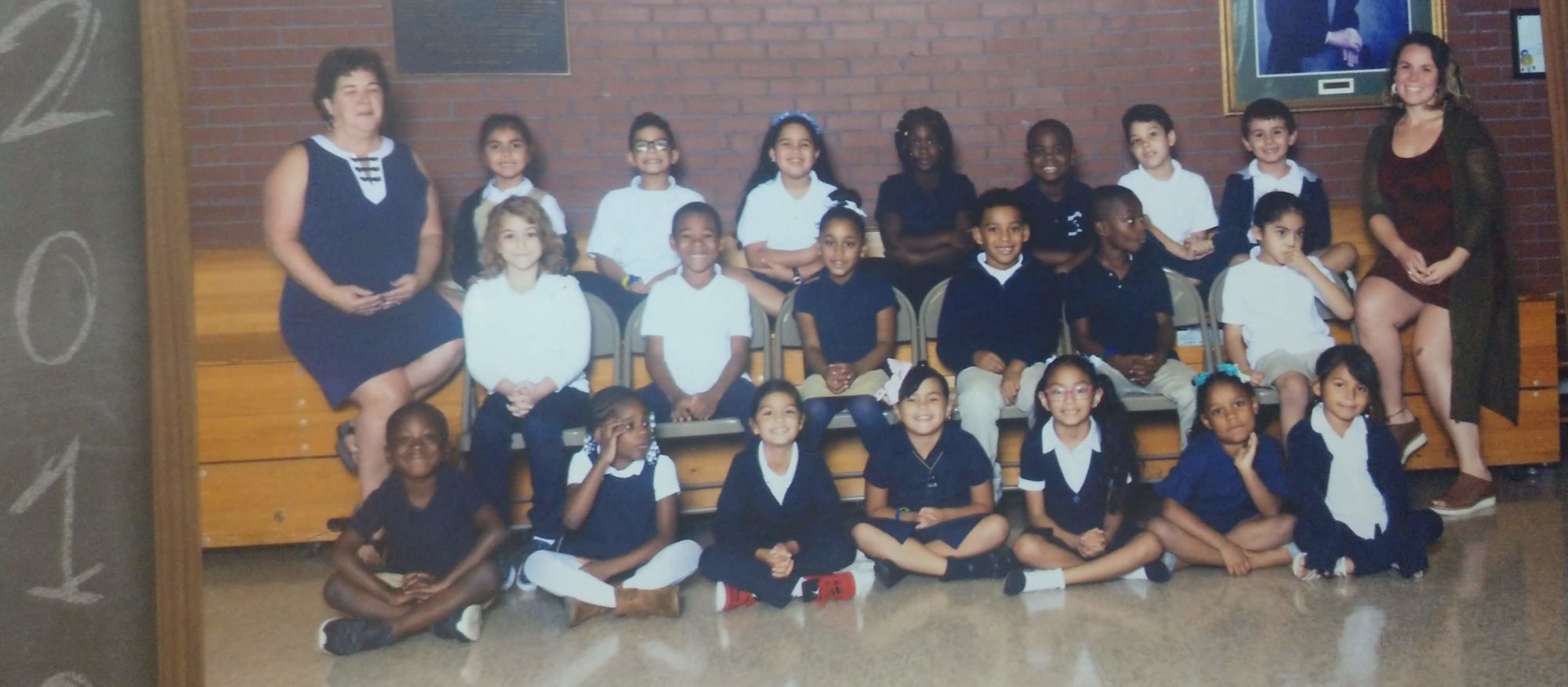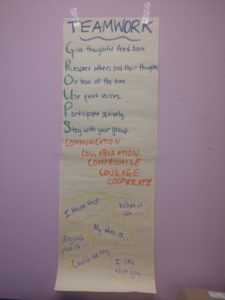Additional to the many particular learning goals of each unit this year, the following were key learning goals I had throughout the year and which applied to each unit:
Being a good citizen: What does it mean?
- Students will be able to work collaboratively and communicatively in teams.
In this unit, students created contracts for their table groups of actions they were committed to taking in order to be good citizens. After hearing the read aloud on Harriet Tubman and reflecting on things they could committ to keep our classroom community the way they wanted it to be (which they brainstormed together), students created contracts for their tables in groups.
- Students will develop the skills to harness their inquisitiveness and curiosity through question-making, conversations, and researching.
Throughout this unit on what it means to be a “good citizen,” students were constantly applying what they learned about this concept to their daily lives. As they spoke with guest speaker Jenny Villegas Garcia, read about Harriet Tubman, and identified the communities they are a part of, they were able to more readily apply that knowledge to their actions in the classroom. After an impactful lesson where we created “contracts” of actions we were committed to doing as a class to make our classroom safe, clean, and joyful, a student suggested we have daily clean up crews outside for recess. I was so proud of her for making this connection and it stayed with our class for several months!
- Students will be able to use words in reading, writing, and speaking that express their understanding.
Like all of my lessons, this unit on what it means to be a “good citizen,” students were constantly asked to express themselves in multiple different ways. This unit especially asked students to access a lot of their prior knowledge and experience in the world to inform our conversations. Asking questions like Who do you see in your life that is a good citizen? and What communities are you a part of where you could be a good citizen? Were critical to the powerful learning in this unit, and fueled our conversations. Students were asked to do a lot of writing about the communities they are a part of, although the majority of the self-expression in this unit was through conversations.
For many of my students who are English Language Learners (ELLs), this time to speak is critical to their language acquisition as they transition their thoughts from conversational and low-stakes conversations to more academic.
Engineering: How to create a boat of found materials that floats?
- Students will be able to work collaboratively and communicatively in teams.
This engineering unit was entirely teamwork based. The only parts of this unit that were done individually were the beginning stages of brainstorming, and a few individual self-reflections and assessment I had my students complete. Besides for these two components, the unit was all done in teams. As are so many lines of work, engineering is an incredibly collaborative type of work. It takes many minds to problem solve and find solutions. Because of this, and also to practice the social-emotional skills of working in teams, I had my student work together.
- Students will develop the skills to harness their inquisitiveness and curiosity through question-making, conversations, and researching.
As is the nature of engineering, students were called to probe the problem at hand – What materials can we use to make a boat that is strong and floatable? They had the opportunity build and test two times which was foundational to their question-making and dialogue around the purposes of different materials, and the creativity which they could harness to makea. boat that was still functional.
- Students will be able to use words in reading, writing, and speaking that express their understanding.
The many self and group assessments and reflections that were required in this unit was a main source for writing, speaking, and expressing themselves. A huge part of being an effective team member I think is having some self-awareness. Since school is so structured and generally has a one-way direction of assessment teacher-to-student, my goal in implementing self-assessment and reflection was to change this narrative that I am the only assesser of their work, and also to encourage them to have awareness of their progress and impact on their group. After several lessons they were asked to reflect on questions like “Was I listening to my peers,” “Was I compromising when needed,” “Did I create a boat I’m proud of,” etc.
Social studies: What is culture and why should we care?
- Students will be able to work collaboratively and communicatively in teams.
Although this unit had a lot of independent work involved in researching their own culture, there were several points where teamwork was necessary. In the seventh lesson students were working in groups to figure out what they could learn about a culture based on a fairytale they all knew, Cinderella. By reading the story out loud to one another, they spoke about what they could learn about the culture from the way the pictures were made, what kind of foods they were eating, what setting they were in, their family structure, etc.
The final lesson was a partner assignment to do an interview to learn more about someone else’s culture. they practiced skills learned especially during the engineering unit on how to listen, stay on task, ask questions, not interrupt, and overall be a team player.
- Students will develop the skills to harness their inquisitiveness and curiosity through question-making, conversations, and researching.
During this unit, students had the opportunity to research about their own cultures. As they read and watched videos relating to the cuisine, values, physical terrain, famous figures of the culture, etc., they developed more and more questions which led their curiosity. The guest visitors to our classroom also piqued the interest of many students and guided their research more. My class’s interest in their cultural background was very naturally harnessed into some great researching and writing skills!
- Students will be able to use words in reading, writing, and speaking that express their understanding.
Throughout this unit students had the opportunity to read about their own culture, write about their own culture as well as the culture of whatever version of Cinderella they were reading in groups, and many opportunities to express themselves through conversation. This unit used Turn and Talks as a tool for getting every student involved in the conversation, and was especially critical for my ELL students to practice their oral expressive skills as a bridge to increasing their academic reading and writing. It was wonderful to see all my students speak about their cultures in their final videos, as well as supplement that with their written research.
Additional to my units, Writing Workshop and Pen-Pal letter writing were ways I met my key learning goals.
Wednesday Writing Workshop
Writers who chose to share during our weekly writing workshops had to be very brave and ready to accept both compliments and feedback. As their peers, students were concerned with framing their feedback in a positive way so that students could take the feedback for their advantage. This sharing of knowledge and advice is central to my learning goal that students will be able to “work collaboratively and communicatively in teams.”
To aid in this feedback process, I offerred students a sentence structure they could use if they needed help:
I liked it when you said ___________ and I think you could add/change ___________ to make it even better.
Using this model and expressing their ideas is in direct alignment with my goal of having students be able to express themselves through reading, writing, and speaking to show their understanding.
Pen-pal letter writing
At the beginning of the year I decided to reach out to my own second grade teacher from 2003 to see if she was still teaching and if she’d be interested in setting up a pen-pal writing project between our two classess. She agreed, and it was a fruitful writing process and a joy for my students!
Writing letters with an unkown person requires some abstract thinking and dedication to know that there’s a kid on the other end of the letter-writing who is equally as excited. For some of my students, this was a challenge, but for many of them, it was an absolute treasure. They loved receiving letters and couldn’t wait to respond to them.
Writing these required my students to practice expressing themselves through writing so that another student could understand them (directly addressing my goal for students to express themselves through reading, writing and speaking).
It was also a fabulous outlet for students to ask questions and inquire to someone else. They were so curious about their pen-pals, the questions often flowed out, and my job was to make sure they were also telling their partners a little about themselves, instead of just a list of questions (meeting my goal that students will develop the skills to harness their inquisitiveness and curiosity through question-making, conversations, and researching).

